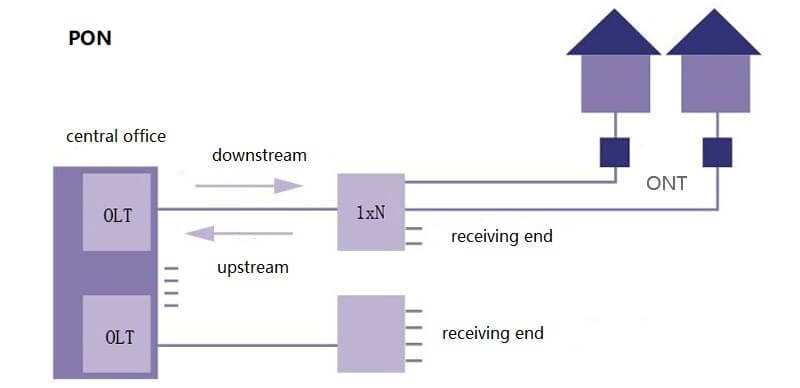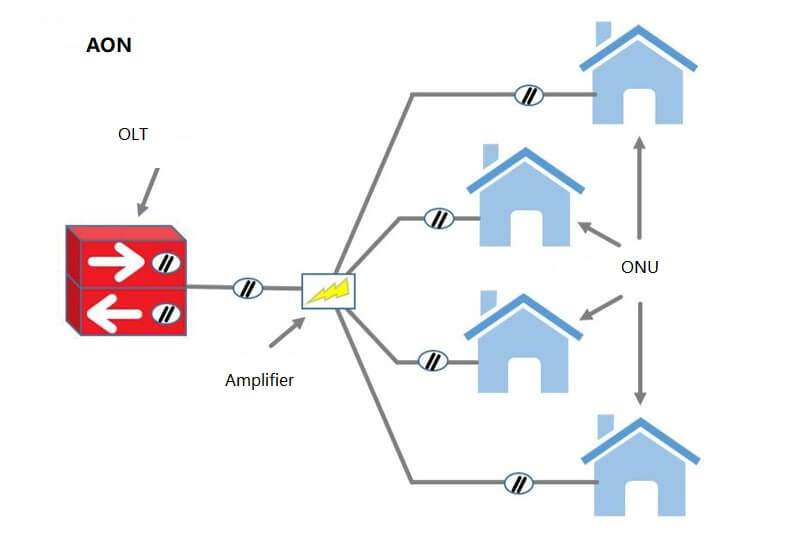Fiber to the home (FTTH) is a system that installs optical fibers directly from a central point to buildings such as corporate offices, residences, and apartments. According to the different equipment in the network structure, fiber-to-the-home (FTTH) networks can be roughly divided into passive optical network (PON) and active optical network (AON). Passive optical network (PON) refers to the network structure without any active electronic components, while active optical network (AON) is on the contrary. This tutorial will cover both types of networks in detail.
Briefly introduce passive optical network (PON) and active optical network (AON)
Before understanding the difference between passive optical networks and active optical networks, let’s briefly understand these two kinds of networks.
Passive optical network (PON) overview
Passive optical network (PON) is mainly composed of an optical line terminal (OLT) at the central office end and an optical network unit (ONU) at the user end. It is a point-to-multipoint network. It can flexibly form topological structures such as a tree, star, bus, etc., and only need to install a simple optical splitter at the optical branch point, so it has the advantages of saving optical cable resources, sharing bandwidth resources, and saving fiber cable room investment. It also has the advantages of fast network speed and low cost of comprehensive network construction.

Active optical network (AON) overview
Active optical fiber transmission equipment such as photoelectric conversion equipment, active optoelectronic devices, and optical fibers, etc is deployed between the central office end and the user end of the active optical network (AON), which can be divided into PDH-based and SDH-based active optical networks (AON), currently commonly used SDH-based active optical network (AON). It has an access rate of 155Mbs or 622Mbs, and the transmission distance can reach 70km without repeaters. Different from the passive optical network (PON), the signal received by the optical network unit (ONU) in the active optical network (AON) is the signal after the optical-electrical-optical conversion of the active equipment. The technology of active optical network (AON) is very mature, but its deployment cost is higher than that of passive optical network (PON).

Difference between passive optical network (PON) and active optical network (AON)
Passive optical network (PON) and active optical network (AON) are two access technologies for building DWDM and CWDM backbone networks in FTTH systems. Both have their own advantages. What are the main differences between them? And how to choose?
Signal distribution: The difference in signal distribution is the biggest difference between passive optical network (PON) and active optical network (AON). In a passive optical network (PON), there is a situation where users share fiber bundles, while in an active optical network (AON), each user has an independent fiber chain, and there is no shared bandwidth with each other. Therefore, relatively speaking, the speed of passive optical network (PON) system is not as fast as that of active optical network (AON), and it is more difficult to troubleshoot when a fault occurs.
Cost: As we all know, the main source of network cost is power supply equipment and maintenance. It can be seen from the above that the passive optical network (PON) has no other power supply equipment except the two ends, and requires less maintenance and no power supply; while the active optical network (AON) mainly performs network transmission through the power supply equipment, so generally speaking, the cost of active optical network (AON) is higher than that of passive optical network.
Coverage: Passive optical networks (PONs) typically only cover distances up to 20 kilometers, while active optical networks (AONs) can cover distances of about 100 kilometers. That is, users in a passive optical network (PON) must be close to the incoming signal.
Application: In addition to the factors mentioned above, other factors need to be considered in practical applications. For example, when it comes to radio frequency deployment and video services, a passive optical network (PON) is more appropriate; if the target user has high network requirements or a large number of users (such as commercial customers or multiple residential buildings), choose active optical networks (AONs) are more suitable.
In addition to the differences mentioned above, there are other differences between the two networks. For example, industry standards, popularity, etc. For example, the AON network is currently the industry standard. Adding new devices to the network is simple. AON is a power supply network that is not as reliable as PON. However, because the bandwidth in a PON is not dedicated to individual users, those using passive optical networks may find their systems slow down during peak usage hours.
Summary
In general, passive optical network (PON) and active optical network (AON) have their own characteristics. Whether it is to deploy passive optical network (PON) or active optical network (AON), it needs to be completed according to the actual situation, the two networks can be mixed in different situations. As the need for network interoperability and scalability continues to grow, future network architectures will allow the free switching of fibers in passive optical networks (PON) and active optical networks (AON).
Bonelinks mainly produces optical communication products such as optical network devices and equipment, and provides related solutions, including GEPON, GPON, optical fiber transceivers, Ethernet switches and other optical terminal equipment, optical fiber connectors, optical fiber adapters, optical fiber splitters, optical fibers distribution box and other fiber optic equipment. Products are widely used in telecommunications operations, radio and television operations, private network operations and other fields. Please contact us if you want to learn more.



